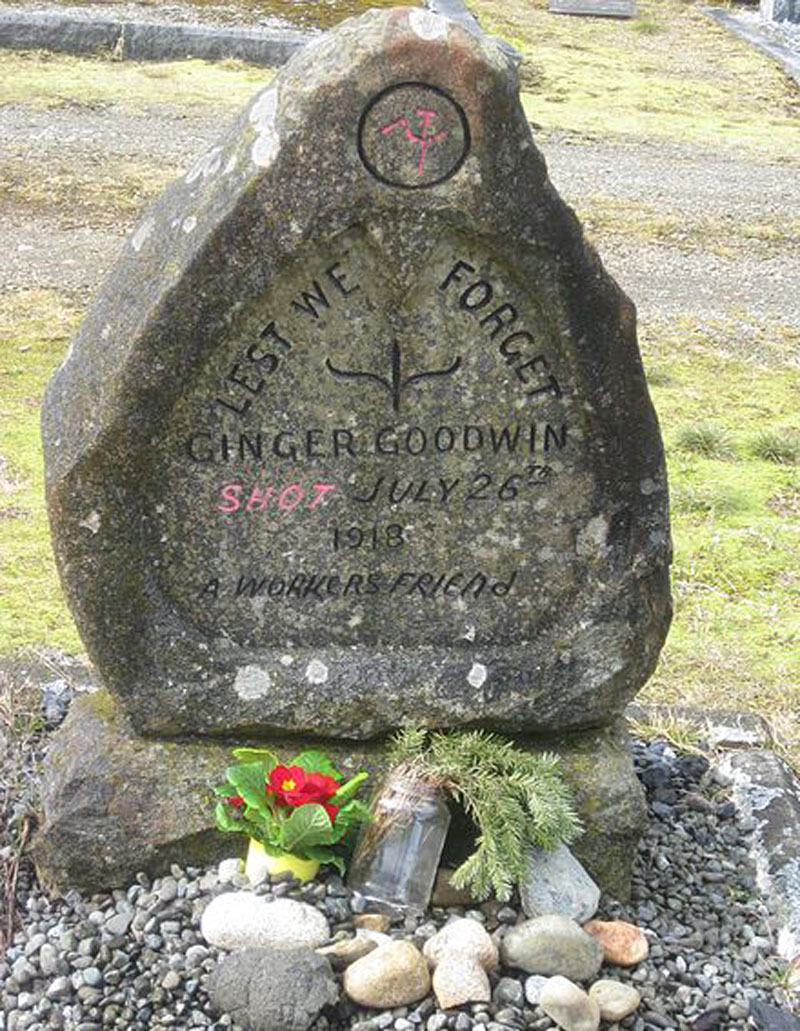
The company Goodwin worked for paid white miners about $4 a day, support workers less and Chinese workers a fraction of that.
Conditions were brutal—men and boys died in explosions and rockfalls, or from breathing toxic vapours.
Coal dust inhaled over years settles into the lungs, scarring them. The scars continue to grow until miners develop breathing problems, commonly known as black lung disease. The resulting lack of oxygen affects internal organs, particularly the heart and brain. It was a miserable way to earn a living and a worse way to die.
In the early 1900s, miners in British Columbia felt their wages did not reflect the danger of their work, so they tried to unionize. Coal companies hampered their efforts by routinely getting rid of leaders.
Strikes spread from colliery to colliery on Vancouver Island in 1912 as miners advocated for higher pay, safer working conditions and the right to unionize. Goodwin, a socialist, became a union organizer. By 1913, nearly 3,500 miners were off the job.
The mining companies hired replacement workers and when riots became widespread, the province sent in 1,000 militiamen to restore order.
“The time for revolution is rotten ripe,” Goodwin wrote in 1913.
The strike wore on for two years and petered out in the early days of the First World War. But discontent remained.
Conditions were brutal—men and boys died in explosions and rockfalls, or from breathing toxic vapours.
During the war, socialism and unionization became more popular. Many farmers and labourers felt the working class was bearing the brunt of wartime hardship and sacrifice, and that business owners were making a fortune on the backs of workers.
But business leaders and politicians thought the two movements would pave the road for revolution and communism. They warily watched the continued political unrest following the 1905 Russian Revolution, and then after the successful 1917 Russian Revolution.
Goodwin, who was among those blacklisted by mine owners, eventually found work at the smelter in Trail, B.C., where he carried on his union activities.
His speeches and articles worried business leaders and politicians. Goodwin, who called for the end of private ownership of the means of production, was loudly antiwar and advocated for the election of union members.
As the First World War progressed, Goodwin forged his reputation as a respected labour leader. He was elected full-time secretary of the Trail Mill and Smeltermen’s Union in 1916. In 1917, he was elected vice-president of the B.C. Federation of Labour, district president of the International Union of Mine, Mill and Smelter workers and president of the Trail Trades and Labour Council.
About two weeks into the smelter strike, Goodwin, 31, was reclassified as fit to serve. His supporters believed it was a move to get rid of him.
That year, Goodwin led a strike of 1,500 men that shut down work at the Trail smelter for a month. Workers were paid $2.75 for a nine-hour day; the men wanted the day reduced to eight hours.
When conscription was introduced in August 1917, Goodwin was declared temporarily unfit for active duty. He already had symptoms of black lung disease. He was scrawny, suffered from stomach problems and had bad teeth.
About two weeks into the smelter strike, however, Goodwin, 31, was reclassified as fit to serve. His supporters believed it was a move to get rid of him. He lost appeals against the reclassification and was ordered to report to army barracks for duty.
Instead, he headed for the hills on Vancouver Island, and soon others who opposed the war or conscription followed. Local supporters supplied the men for months as officials launched a manhunt.
On July 27, Constable Daniel Campbell of the Dominion Police found Goodwin in a cabin at Alone Mountain near Comox Lake.
Campbell shot him. Then burned down the cabin.
Campbell claimed he’d shot in self-defence, but Goodwin’s supporters believed he’d been murdered. Though witnesses said he had vowed to get the fugitives dead or alive, Campbell was not tried.
Between 1917 and 1920, an estimated 350,000 Canadian workers had participated in more than 1,000 strikes.

In Vancouver on Aug. 2, 1918, stretching side-to-side across the front page of The World newspaper was the headline: “TWENTY-FOUR HOUR STRIKE BEGAN AT NOON.”
The dockyards fell silent. Streetcars stopped mid-route. Sewing machines at textile plants ceased humming and construction workers put down their tools.
The strike was timed to coincide with Goodwin’s funeral.
Men who had fought shoulder-to-shoulder in the trenches were now willing to band together to fight for jobs and better working conditions.
In Cumberland, Goodwin’s casket, carried on workers’ shoulders, led a funeral procession stretching about two kilometres.
It was the start of Canada’s first general strike—but it would not be the last. The Winnipeg General Strike of 1919 involved workers across the country and disputes relating to that strike continued to 1925.
The strike Goodwin had started in 1917 ultimately ended without achieving its aims, but by March 1919, British Columbia had enacted an eight-hour day for smelter workers.
Between 1917 and 1920, an estimated 350,000 Canadian workers had participated in more than 1,000 strikes.
The First World War changed Canada, its society, its workplaces and its politics.
Men who had fought shoulder-to-shoulder in the trenches were now willing to band together to fight for jobs and better working conditions. And workers who had not seen combat overseas had learned the power of co-operative action in bargaining with employers. Pro-labour political parties soon followed.
Governments that had at first came down hard on strikes and labour leaders became more and more involved in regulating the workplace, legislating safety standards, limiting the length of workdays and the work week and establishing minimum wages.
Advertisement












